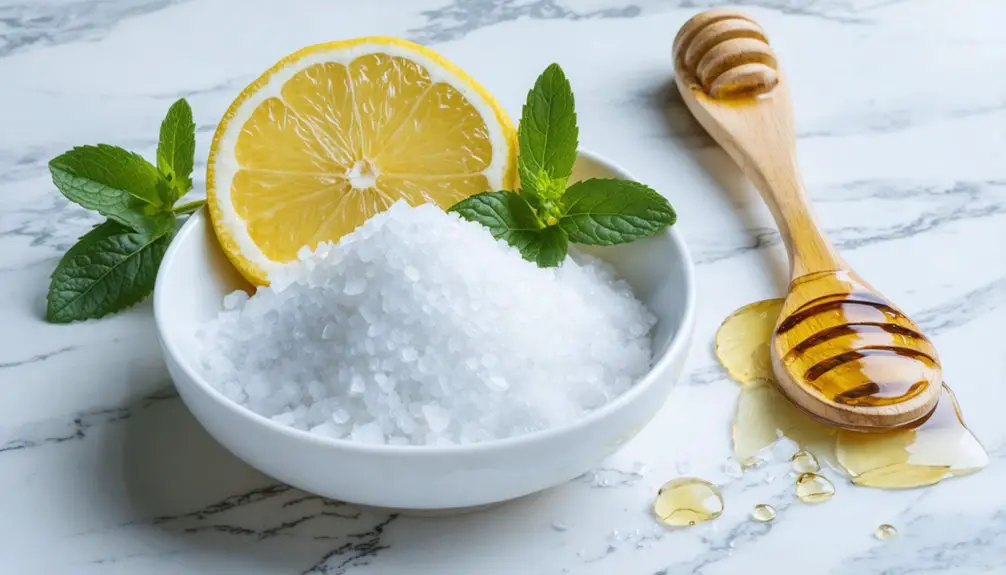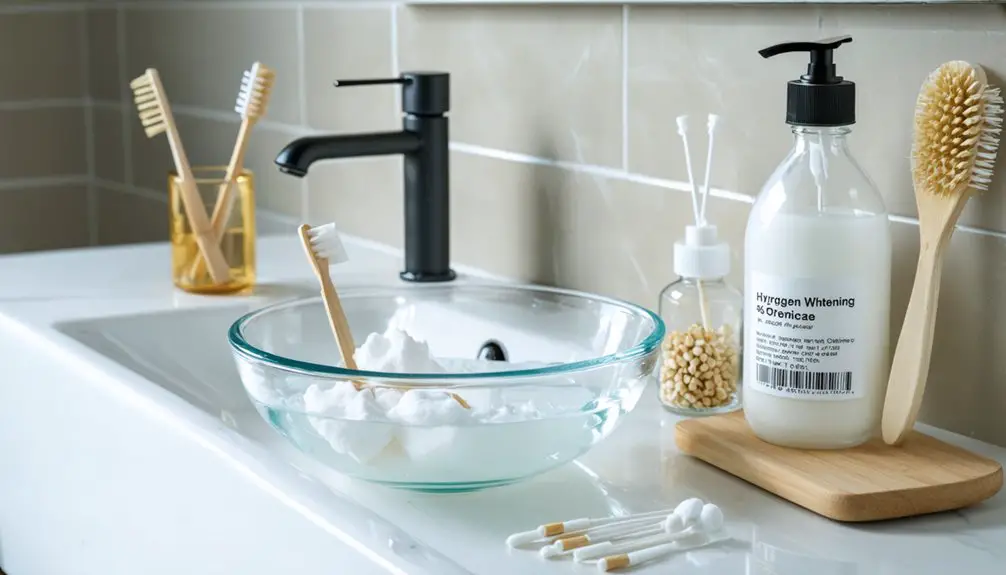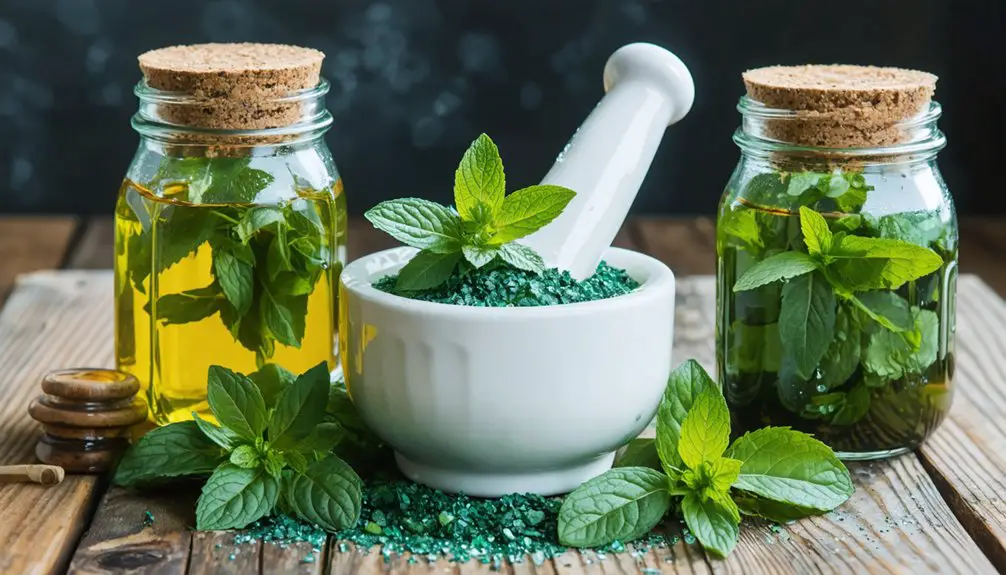Home remedies offer you a safer, more cost-effective approach to teeth whitening compared to chemical treatments. Natural ingredients like bromelain enzymes and baking soda break down stains while preserving your enamel’s integrity, unlike harsh peroxide-based products that can cause sensitivity and damage. You’ll spend mere cents per application versus hundreds on professional treatments, while maintaining beneficial oral bacteria. Discover how these gentle solutions can transform your smile through scientifically-backed natural methods.
Key Takeaways
- Home remedies are significantly more cost-effective, costing cents per application compared to hundreds for professional treatments.
- Natural whitening methods like bromelain and ficin offer gentler whitening while preserving enamel hardness better than chemical treatments.
- DIY whitening gives users complete control over application and intensity, allowing immediate stopping if sensitivity occurs.
- Common household ingredients like baking soda and coconut oil are readily accessible and provide additional oral health benefits.
- Natural whitening supports beneficial oral bacteria balance while avoiding harsh chemicals that can damage teeth and gums.
Natural Ingredients Vs Chemical Alternatives
While both natural and chemical teeth whitening solutions aim to brighten your smile, they differ significantly in their effectiveness, safety profiles, and scientific backing.
Chemical whiteners like hydrogen peroxide show proven results but can cause sensitivity and enamel damage when misused. Dental professionals recommend dentist supervision for any whitening treatment to minimize risks.
Natural remedy effectiveness varies – ingredients like bromelain and ficin demonstrate promising whitening comparable to peroxide-based products while being gentler on enamel.
Chemical safety concerns include tissue irritation and structural damage from improper use of over-the-counter products. Studies show that 80% of patients experience tooth sensitivity after professional whitening treatments.
Though natural alternatives like turmeric and activated charcoal lack substantial scientific evidence, enzymatic agents offer additional benefits like anti-inflammatory and antimicrobial properties.
When choosing between options, consider that natural remedies typically cause less enamel damage but have less consistent results due to unstandardized formulations, while chemical treatments require careful adherence to safety guidelines.
Cost-Effective Solutions for a Brighter Smile
You’ll find that natural whitening ingredients like baking soda and activated charcoal cost mere cents per application, compared to hundreds of dollars for professional treatments.
These budget-friendly alternatives enable you to maintain whiter teeth through regular home care without straining your finances. Professional whitening treatments can cost up to ten billion dollars industrywide by 2030.
However, it’s important to note that acidic home remedies can potentially damage tooth enamel and should be avoided despite their perceived whitening benefits.
Budget-Friendly Natural Ingredients
Natural teeth whitening doesn’t require breaking the bank, as numerous cost-effective ingredients are readily available in most households. You can create homemade pastes using activated charcoal, baking soda, or natural oils to achieve noticeable results without expensive treatments. These ingredients effectively remove surface stains while being gentle on your enamel. Consulting with a licensed dental professional is recommended before starting any whitening regimen to ensure safety and effectiveness.
Common kitchen items like strawberries and banana peels offer whitening properties through their natural enzymes and minerals. You’ll find that diluted hydrogen peroxide serves as an effective bleaching agent at a fraction of professional treatment costs. Including crunchy fruits and vegetables in your diet can naturally clean teeth while promoting overall oral health.
Long-Term Savings Potential
Adopting home-based teeth whitening solutions offers substantial long-term financial benefits compared to professional treatments.
While professional whitening may cost between $350 to $1,200 per session, you’ll spend only $5 to $60 on home remedies, making them an excellent choice for long-term budgeting.
Popular products like Crest Whitestrips cost between $25 and $60, providing an affordable entry point for those new to teeth whitening.
Your financial planning benefits from the flexibility to spread costs over time rather than facing large upfront expenses. You’ll avoid indirect costs like travel expenses and lost work hours associated with dental visits.
Home treatments provide 3 to 6 shades of whitening improvement after consistent use over a couple of weeks.
Additionally, the gentle nature of home treatments reduces the risk of costly enamel damage or sensitivity issues that often accompany professional procedures.
Affordable Daily Maintenance Tips
Looking for cost-effective ways to maintain a bright smile? You’ll find that daily brushing and proper flossing techniques are your most powerful tools for maintaining tooth whiteness.
Brush twice daily with whitening toothpaste and use dental floss to remove plaque between teeth where stains often begin. Professional testing shows that whitening toothpastes effectively remove surface stains while being gentle on enamel. Over-the-counter strips can provide dramatic whitening levels at a fraction of professional treatment costs.
For stain prevention, rinse your mouth immediately after consuming dark beverages like coffee or tea. Choose healthy snacks such as crunchy fruits and vegetables, which naturally clean your teeth while providing essential nutrients.
Incorporate simple whitening habits like oil pulling with coconut oil or using a baking soda paste once weekly. These affordable maintenance steps, combined with regular dental check-ups, will help preserve your smile’s brightness without straining your budget.
Safety Advantages of DIY Whitening Methods
When considering teeth whitening options, DIY methods offer significant safety advantages over professional treatments and commercial products.
You’ll minimize exposure to harsh chemicals by using natural ingredients like baking soda and activated charcoal instead of high-concentration peroxide products that can damage your enamel. These gentler alternatives reduce risks of tooth sensitivity and gum irritation while providing gradual, controlled results.
Safety precautions are easier to maintain with DIY methods since you control the application process and can adjust treatments based on your user experiences.
You’ll be able to monitor sensitivity levels and stop immediately if discomfort occurs. The affordability of home remedies also encourages consistent, gentle whitening rather than aggressive treatments that might harm your teeth, making it a safer long-term approach to dental care.
The Science Behind Natural Whitening Agents
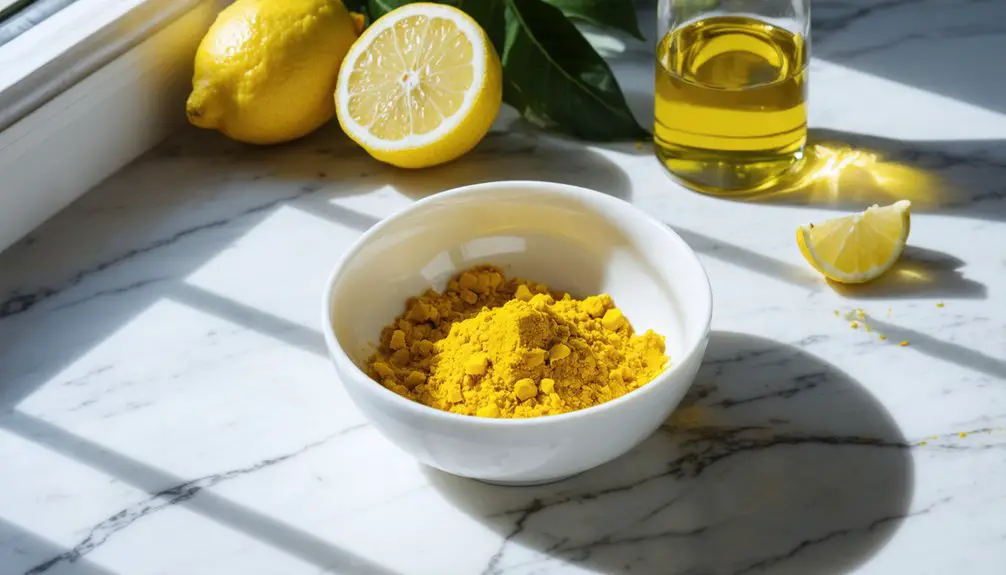
Natural whitening agents operate through distinct chemical mechanisms that set them apart from conventional peroxide treatments. While peroxides work through oxidation, natural agents like papain and bromelain utilize enzymatic processes to break down protein-based stains.
These enzymes’ effectiveness has been scientifically validated, showing they can achieve whitening results while being gentler on your enamel.
The whitening mechanisms of natural agents vary: some work through mild abrasion, like baking soda, while others function through enzymatic action.
You’ll find that natural enzymes target organic stains by breaking down their molecular structure, rather than using harsh oxidative processes.
Research indicates these methods preserve enamel hardness better than peroxide-based treatments, making them a scientifically sound choice for those seeking safer whitening alternatives.
Long-Term Benefits for Dental Health
When you use natural whitening remedies, you’ll maintain your mouth’s beneficial bacterial balance while avoiding the harsh chemicals found in commercial products.
Your teeth’s natural defense mechanisms stay intact, allowing for better protection against decay and sensitivity over time.
Regular use of gentle, natural whitening agents strengthens your enamel through gradual mineralization, ensuring your smile stays both bright and healthy for years to come.
Natural Bacterial Balance Maintained
Although many people focus on quick cosmetic results, maintaining a healthy bacterial balance in your mouth plays an essential role in both teeth whitening and long-term dental health. Your oral cavity hosts over 700 species of microorganisms, and their bacterial diversity directly impacts your overall wellness.
When you use natural whitening methods like baking soda, you’ll help maintain microbiome balance while gently removing stains. Foods that stimulate saliva production, such as broccoli and hard cheeses, support this process by naturally neutralizing harmful bacteria.
You’ll also benefit from baking soda’s ability to increase oral pH, creating an environment where destructive bacteria can’t thrive. This approach not only brightens your smile but also strengthens your immune system and promotes better cardiovascular health through a well-balanced oral microbiome.
Promotes Lasting Enamel Strength
Home remedies for teeth whitening offer significant advantages for maintaining enamel strength compared to harsh commercial treatments. When you use natural whitening methods, you’ll protect your teeth’s mineral density while achieving a brighter smile.
These gentle approaches focus on enamel remineralization techniques that support your teeth’s long-term health. Natural pH balancing occurs through ingredients like baking soda, which neutralizes harmful acids while safely removing surface stains.
You’ll find that fruit peels contribute trace minerals that support enamel restoration, while oil pulling helps reduce bacteria that could otherwise damage your teeth. By avoiding aggressive bleaching chemicals, you’re preserving your enamel’s microstructure and preventing sensitivity issues.
The combination of mechanical stain removal and natural ingredients guarantees your teeth stay strong and healthy while gradually becoming whiter.
Gentle Approach to Teeth Sensitivity
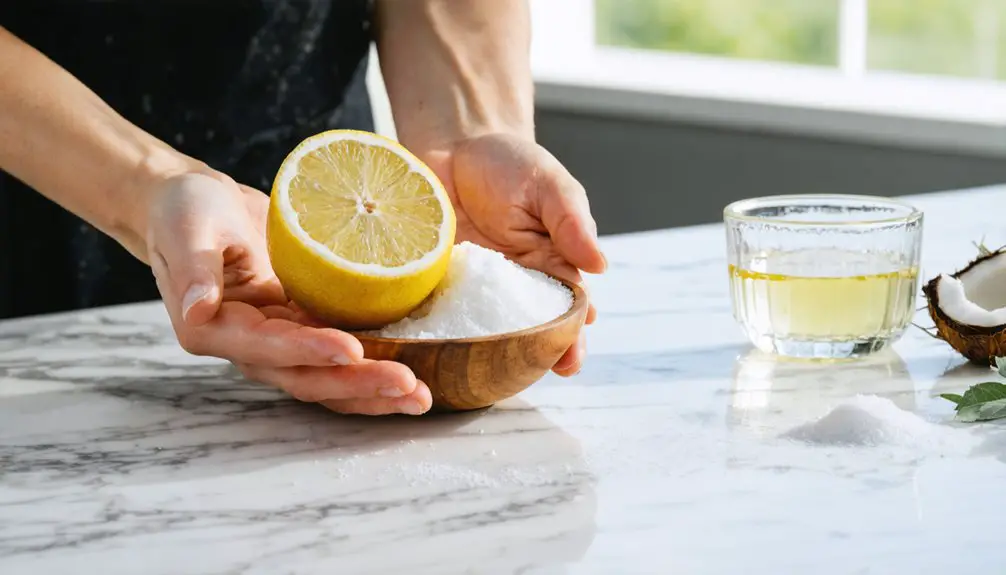
For those with sensitive teeth, achieving a brighter smile requires gentle whitening methods that won’t compromise dental health or increase discomfort.
You’ll find safe options like oil pulling with coconut oil, which naturally fights bacteria and plaque without harsh chemicals or abrasives.
When using baking soda, create a paste with water rather than acidic substances to protect your enamel while still removing surface stains.
If you’re considering hydrogen peroxide, opt for diluted mouthwash solutions and limit use to a few times weekly.
For sensitivity prevention, avoid combining acidic agents with abrasives, and never exceed recommended treatment durations.
Natural approaches like strawberries offer milder whitening effects than lemon juice, making them a safer choice for sensitive teeth.
Remember to prioritize gentle whitening techniques that maintain your enamel’s integrity.
Accessibility and Convenience Factors
Three key factors make teeth whitening more manageable at home: minimal cost, readily available ingredients, and flexible scheduling. You’ll find user friendly applications with over-the-counter products and natural remedies that won’t strain your budget.
These options give you complete user control over your whitening routine without requiring dental appointments.
Take charge of your smile enhancement journey with flexible home whitening solutions that fit your schedule and preferences.
The accessibility of common household ingredients like baking soda and coconut oil means you can start whitening immediately. You’ll appreciate the convenience of portable whitening strips and gels when traveling, and you can adjust the frequency of treatments based on your schedule.
While professional treatments may offer stronger results, home remedies provide a practical balance of effectiveness and convenience, allowing you to maintain your smile on your terms.
Supporting Overall Oral Wellness
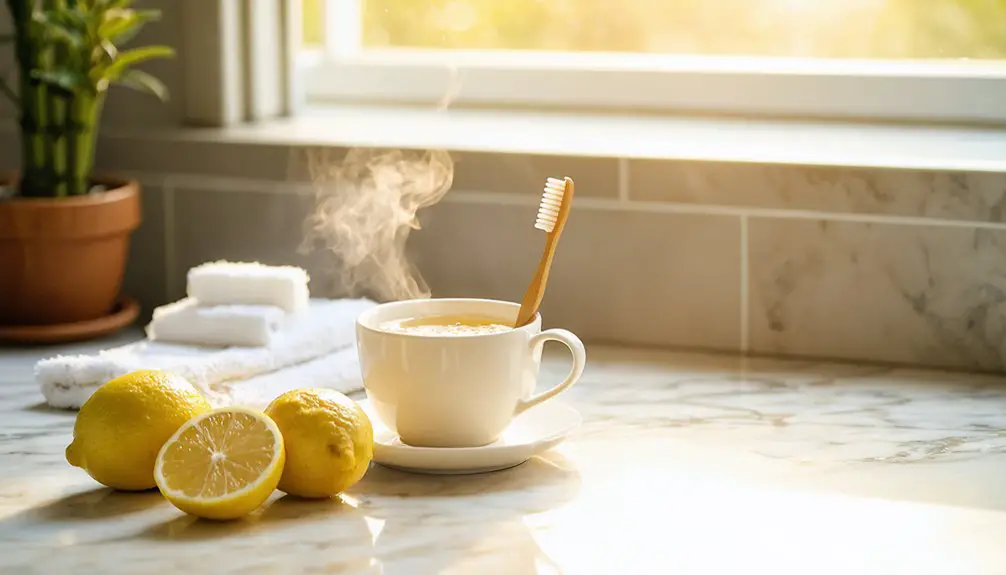
While brightening your smile remains the primary goal, natural teeth whitening methods offer significant benefits for thorough oral health. When you use gentle, natural approaches, you’re supporting your oral microbiome while achieving a whiter smile. These methods help prevent gum inflammation and protect your teeth’s natural defenses.
- Oil pulling with coconut or sesame oil reduces harmful bacteria while freshening breath.
- Baking soda’s alkaline properties neutralize acids and protect enamel integrity.
- Natural antioxidants help balance oxidative stress in your mouth.
- Fluoride-containing home remedies strengthen enamel during whitening.
- Mild natural ingredients preserve beneficial oral bacteria essential for health.
These holistic benefits make natural whitening methods particularly valuable for maintaining long-term oral wellness, extending far beyond cosmetic improvements.
Sustainable Results Through Regular Use
Achieving lasting teeth whitening results requires consistent application of gentle home remedies rather than relying on aggressive one-time treatments.
When you maintain a regular whitening frequency using mild abrasives like baking soda or natural acids from fruits, you’ll see gradual improvement while protecting your enamel’s integrity.
You’ll find that home remedies work progressively to remove both existing stains and prevent new ones from setting in.
By applying these treatments consistently, you’re able to control the pace of whitening based on your sensitivity levels while maintaining the results long-term.
This sustainable approach proves more cost-effective than professional treatments and reduces risks of enamel damage.
The key is patience – steady, measured applications will deliver lasting brightness without compromising your dental health.
Frequently Asked Questions
How Long Should I Wait After Eating Before Using Natural Whitening Remedies?
You’ll need to wait 30-60 minutes after eating before using natural whitening remedies. Timing considerations depend on your eating habits, as acidic foods require longer waiting periods for enamel protection.
Can Natural Whitening Methods Remove Deep Stains From Medications or Antibiotics?
While up to 90% of surface stains respond to natural remedies, you won’t effectively remove deep medication-induced stains naturally. These intrinsic discolorations require professional whitening treatments to penetrate your tooth’s internal structure.
Are Home Remedies Safe to Use With Dental Crowns or Veneers?
You shouldn’t use home remedies with dental crowns or veneers, as they can damage your restorations. For proper dental crown safety and veneer care, always consult your dentist for professional whitening options.
Should Children Use Natural Teeth Whitening Remedies?
For children’s dental health, you shouldn’t use natural whitening remedies until age 15. Instead, focus on preventive care, healthy eating habits, and gentle cleaning with age-appropriate products containing safe natural ingredients.
How Often Should I Rotate Between Different Natural Whitening Methods?
You’ll want to alternate natural whitening methods just 1-2 times weekly, allowing 2-3 days between different techniques. Follow frequency guidelines carefully to maintain method effectiveness while protecting your enamel.
References
- https://pmc.ncbi.nlm.nih.gov/articles/PMC10024105/
- https://healthcare.utah.edu/the-scope/health-library/all/2023/10/does-home-teeth-whitening-really-work
- https://www.frontiersin.org/journals/dental-medicine/articles/10.3389/fdmed.2021.687507/full
- https://www.urmc.rochester.edu/news/publications/health-matters/diy-teeth-whitening-too-good-to-be-true
- https://metdental.ca/4-effective-teeth-whitening-home-remedies/
- https://pmc.ncbi.nlm.nih.gov/articles/PMC9645194/
- https://www.todaysrdh.com/study-shows-natural-tooth-whiteners-as-effective-as-peroxide-whiteners/
- https://pmc.ncbi.nlm.nih.gov/articles/PMC9915942/
- https://www.loudfamilydentistry.com/blog/teeth-whitening-related-statistics-on-effectiveness-and-sensitivity-incidence
- https://www.dentalpartnersofboston.com/at-home-vs-in-office-whitening/
